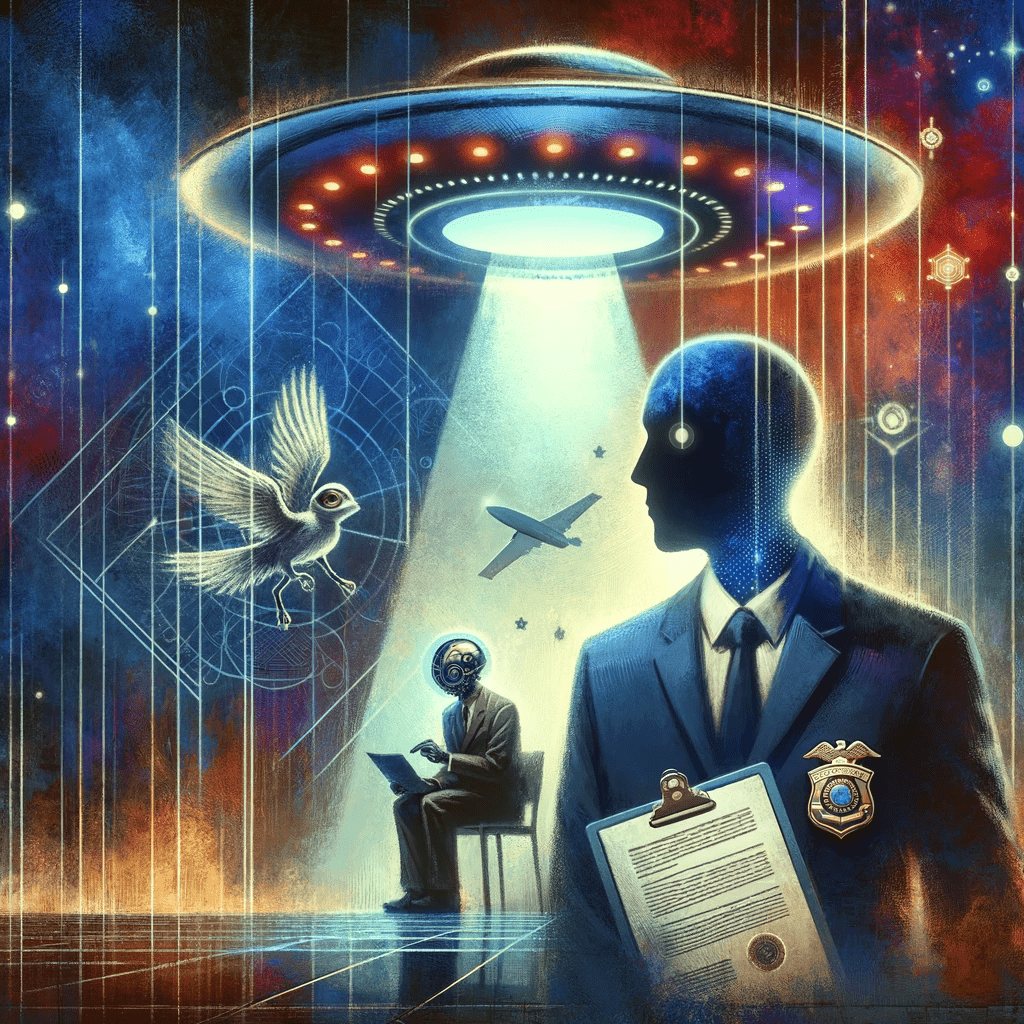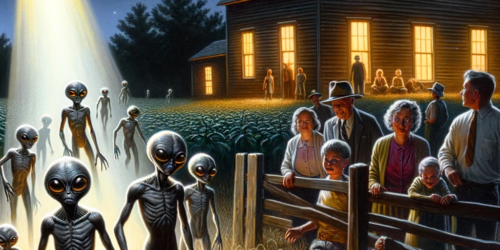How the UFO Stigma was Created?

The U.S. government, which includes bodies such as the CIA and the Air Force, has shown a longstanding interest in unidentified flying objects (UFOs). This interest mainly stems from national security considerations. Over the years, there have been numerous projects and investigations related to this topic. Among the most renowned are Project Blue Book, administered by the Air Force from 1952 to 1969, and the Advanced Aerospace Threat Identification Program (AATIP), a confidential initiative funded by the Department of Defense from 2007 to 2012.
These programs aimed to understand and provide explanations for unidentified aerial phenomena (UAPs), phenomena that could be accounted for by natural or human-made causes. They sought to impart accurate information to both military personnel and the general public. The agencies also endeavored to minimize unnecessary public concern or panic resulting from misconstrued or sensationalized UFO sightings. This involved providing natural explanations for sightings wherever possible and discouraging misinformation or exaggerated interpretations of these events.
There has been criticism over the years about how the U.S. government has handled the topic of UFOs, with some arguing that there has been excessive secrecy or downplaying of potentially significant incidents. The Robertson Panel, a scientific advisory group established in 1952 by the CIA to investigate the UFO issue, concluded that while they didn’t see any evidence that UFOs themselves were a threat to national security, they were concerned about the potential for public panic and the possibility that enemy nations could exploit that panic. They suggested monitoring civilian UFO groups due to the potential for mass hysteria and the capacity for the subject matter to be used for subversive purposes.
The objective of Project Blue Book evolved over time. Initially, it was designed as a serious investigative body to understand and explain UFO sightings. However, as time went on and no clear evidence of extraterrestrial life was found, the project became more focused on explaining away sightings and reducing public interest in UFOs. This shift was partly due to the recommendations of the Robertson Panel and the belief that continued public fascination with UFOs could pose a national security issue.
Following the Robertson Panel’s recommendations in 1953, the U.S. Air Force did indeed implement changes to its UFO reporting policies, which were codified in Air Force Regulation 200-2. This policy instructed Air Force bases to send all reports of UFO sightings to a single place for analysis, which at the time was Project Blue Book.
The U.S. Air Force established the 4602nd Air Intelligence Service Squadron (AISS) in 1952, which played a role in investigating UFO sightings. However, the responsibility for investigating UFOs was shared among multiple government agencies and departments, including the CIA, the U.S. Air Force, and the National Security Agency, among others.
The Joint Army Navy Air Publication (JANAP) 146 was a regulation that outlined reporting requirements for unidentified flying objects by military personnel. This regulation was designed to prevent unauthorized release of information about UFO sightings that could potentially compromise national security.
Dr. J. Allen Hynek was an astronomer who served as a scientific advisor to Project Blue Book. Initially skeptical of UFOs, Hynek worked to find conventional explanations for the sightings. However, he grew frustrated with the Air Force’s dismissal of some sightings that he believed were not easily explained. By the late 1960s, Hynek became more open to the possibility that some UFOs might be unexplained and could represent an important scientific anomaly. His developed classification system for encounters with UFOs, including terms like “close encounters of the first kind,” entered popular culture largely through Steven Spielberg’s 1977 film “Close Encounters of the Third Kind.”
Dr. Donald Menzel, a Harvard University professor and a prominent UFO skeptic, wrote several books arguing that UFOs were misinterpretations of natural phenomena. His works significantly influenced public and academic opinions.
Blue Book Special Report No. 14, a statistical analysis of the UFO reports gathered by Project Blue Book, was released in 1955. The report concluded that the vast majority of UFO sightings could be explained by conventional phenomena, but a small percentage (roughly 3-6% depending on the interpretation of the data) remained unidentified.
The Central Intelligence Agency (CIA) has had a complex relationship with the media, influencing public opinion through various means. Operation Mockingbird, an alleged large-scale program of the CIA that began in the early 1950s, attempted to manipulate news media for propaganda purposes. It funded student and cultural organizations and magazines as front organizations.
George Adamski (1891-1965) was a notable figure in the contactee movement, which gained prominence in the mid-20th century. Adamski first came to public attention in 1952 when he claimed to have observed a large cigar-shaped “mother ship.”
Adamski alleged that he had a personal encounter with a visitor from Venus in a scout ship, whom he later referred to as “Orthon.” According to Adamski, Orthon was a male being of somewhat taller stature than the average human, with a physical appearance similar to humans. He described Orthon as having long, blonde hair and wearing a brown jumpsuit.
Adamski claimed that Orthon communicated with him through a form of telepathy, conveying a message of peace and warning about the dangers of nuclear weapons. In subsequent years, Adamski claimed further contacts with extraterrestrial beings and even journeys aboard their spacecraft, including a reported trip to the Moon, Venus, Mars, and Saturn.
Adamski produced several photographs purporting to show UFOs. His most famous photograph supposedly showed a Venusian scout ship. He described the ship as being a silver, saucer-like craft with a dome on top. The craft was said to have a series of port holes around the edge and three spherical landing gear on the bottom.
Project Grudge, which operated from 1948-1951, was an initiative by the U.S. Air Force to investigate UFO reports. The project concluded that UFOs posed no threat to national security and attributed most sightings to conventional phenomena or misinterpretations.
Public faith in institutions was generally high in the post-WWII period, and many people accepted the official explanations for UFO sightings. However, a subset of the population remained intrigued by the UFO phenomenon and continued to report sightings and speculate about possible extraterrestrial origins. Notable figures in this era included Donald E. Kehoe and Frank Scully. Kehoe, a retired Marine Corps Major and aviation writer, became one of the most prominent UFO researchers of his time, arguing that the U.S. government was covering up evidence of extraterrestrial visitation. Scully, a variety journalist, wrote a best-selling book in 1950 titled “Behind the Flying Saucers,” which claimed to reveal inside information about recovered flying saucers and their alien occupants.
In 1952, there was a notable spike in UFO sightings, also known as the “Summer of the Saucers.” This period, which included the famous Washington, D.C. sightings in July 1952, received widespread media coverage. In response, the U.S. Air Force established Project Blue Book, a continuation of Projects Sign (1947-1949) and Grudge (1949-1952), as its most comprehensive initiative for investigating UFO sightings.
The stigma surrounding UFOs has been shaped by a complex interplay of factors. Primarily, U.S. government policies and initiatives, such as Project Blue Book and the AATIP, aimed to investigate and provide natural explanations for unidentified aerial phenomena. However, these explanations often downplayed the potential significance of such phenomena, leading to a public perception that they were not worthy of serious consideration. The recommendations of the Robertson Panel, which emphasized debunking UFO sightings to prevent public panic, further bolstered this perception.
Moreover, policies such as Air Force Regulation 200-2 and JANAP 146 centralized UFO reporting and restricted information release, contributing to an aura of secrecy. High-profile skeptics like Dr. J. Allen Hynek and Dr. Donald Menzel played a significant role in influencing public and academic opinion, often towards dismissal of UFO phenomena.
Personal alien encounters, such as those by George Adamski, and allegations of government cover-ups by figures like Donald E. Kehoe, added to the confusion surrounding UFOs. This, along with potential media manipulation through programs like Operation Mockingbird, further fuelled public skepticism and distrust, casting a shadow of stigma on UFO-related discourse.
The prevailing public faith in institutional explanations during the post-WWII era meant that UFO phenomena were largely marginalized, with those continuing to speculate about extraterrestrial origins often viewed as outliers. This cultural context consolidated the stigma around UFOs, contributing to the perception of UFO phenomena as fringe.



